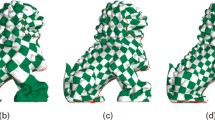Abstract
A common representation of surfaces with complicated topology and geometry is through composite parametric surfaces. This is the case for most CAD modelers. The majority of these models focus on having a good approximation of the surface itself, but they are usually built without taking into account a subsequent mesh generation. Indeed they are often characterized by too many patches which are not logically connected and make a standard mesh generator fail. In this work, we present a novel mesh generation strategy that can handle such “bad” input data and produces an anisotropic curvature-adapted surface mesh. There are two main ingredients to achieve this goal. First of all, we define a new and fast way to project point on an input model which overcomes the presence of non-connected patches. Then we consider the higher embedding strategy to build the final anisotropic surface mesh.











Similar content being viewed by others
References
Alliez P, Ucelli G, Gotsman C, Attene Marco (2008) Recent advances in remeshing of surfaces. In: Shape analysis and structuring, mathematics and visualization. Springer
Boissonnat J-D, Shi K-L, Tournois J, Yvinec M (2015) Anisotropic delaunay meshes of surfaces. ACM Trans Graph 34(2):14:1–14:11
Bossen Frank J, Heckbert Paul S (1996) A pliant method for anisotropic mesh generation. In: Proceedings of the 5th International Meshing Roundtable, pp 63–74, Albuquerque, NM, Sandia National Laboratories
Hiltebeitel AM, Gauss CF, Morehead JC (1902) General investigations of curved surfaces of 1827 and 1825. The Princeton university library, Princeton
Cañas GD, Gortler SJ (2006) Surface remeshing in arbitrary codimensions. Vis Comput 22(9–11):885–895
Cheng S-W, Dey Tamal K, Ramos Edgar A, Wenger R (2006) Anisotropic surface meshing. In: Proceedings of the Seventeenth Annual ACM-SIAM Symposium on Discrete Algorithm, SODA ’06, pages 202–211, Philadelphia, PA, USA. Society for Industrial and Applied Mathematics
Dassi Franco, Si Hang (2015) New challenges in grid generation and adaptivity for scientific computing, chapter A curvature-adapted anisotropic surface re-meshing method. Springer International Publishing, Cham, pp 19–41
de Cougny Hugues L, Shephard Mark S (1996) Surface meshing using vertex insertion. In: Proceedings of the 5th International Meshing Roundtable, Citeseer, pp 243–256
Field David A (1988) Laplacian smoothing and Delaunay triangulations. Commun Appl Numer Methods 4(6):709–712
Michael S (2005) Floater and Kai Hormann. Advances in multiresolution for geometric modelling, Berlin
Frey PJ, Borouchaki H (1998) Geometric surface mesh optimization. Comput Vis Sci 1(3):113–121
Heckbert Paul S, Garland Michael (1999) Optimal triangulation and quadric-based surface simplification. Comput Geometry 14(13):49–65
Hoppe H (1996) Progressive meshes. In: Proceedings of the 23rd annual conference on Computer graphics and interactive techniques, ACM, pp 99–108
Hoppe H, DeRose T, Duchamp T, McDonald J, Stuetzle W (1993) Mesh optimization. In: Proceedings of the 20th annual conference on Computer graphics and interactive techniques, ACM, pp 19–26
Jiao X, Colombi A, Ni X, Hart J (2010) Anisotropic mesh adaptation for evolving triangulated surfaces. Eng Comput 26(4):363–376
Kim H-S, Kim H-S (2009) New computation of normal vector and curvature. W Trans Comp 8(10):1661–1670
Lai Y-K, Zhou Q-Y, Shi-Min Hu, Wallner J, Pottmann Helmut (2007) Robust feature classification and editing. IEEE Trans Vis Comput Gr 13(1):34–45
Lai Y-K, Zhou Q-Y, Shi-Min Hu, Wallner J, Pottmann Helmut (2007) Robust feature classification and editing. IEEE Trans Vis Comp Gr 13(1):34–45
Laug P, Borouchaki H (2012) Proceedings of the 20th International Meshing Roundtable. Berlin, Heidelberg
Lawson CL (1977) Software for C1 surface interpolation. In: Rice JR (ed) Mathematical Software III. Academic Press, New York, pp 161–194
Lévy B, Bonneel N (2013) Variational anisotropic surface meshing with voronoi parallel linear enumeration. In: Proceedings of the 21st International Meshing Roundtable, Springer, pp 349–366
Medioni G (2000) Tensor voting: theory and applications
Mola A, Heltai L, DeSimone A (2014) A fully nonlinearpotential model for ship hydrodynamics directly interfaced with CAD data structures
Owen Steven J, White David R, Tautges Timothy J (2002) Facet-based surfaces for 3d mesh generation. In: Proc. 11 th Int. Meshing Roundtable, pp 297–311
Open Cascade S.A.S. Open cascade technology, 3d modeling & numerical simulation, 2010. http://www.opencascade.org
Surazhsky V, Gotsman C (2003) Explicit surface remeshing. In: Proceedings of the 2003 Eurographics/ACM SIGGRAPH Symposium on Geometry Processing, SGP ’03, Aire-la-Ville, Switzerland, Switzerland, Eurographics Association, pp 20–30
Acknowledgements
The work of Franco Dassi was supported under the “Leibniz - DAAD Research Fellowship 2014”. The work of Andrea Mola was carried out in the context of the project OpenViewSHIP, “Sviluppo di un ecosistema computazionale per la progettazione idrodinamica del sistema elica-carena”, supported by Regione FVG - PAR FSC 2007-2013, Fondo per lo Sviluppo e la Coesione.
Author information
Authors and Affiliations
Corresponding author
Rights and permissions
About this article
Cite this article
Dassi, F., Mola, A. & Si, H. Curvature-adapted remeshing of CAD surfaces. Engineering with Computers 34, 565–576 (2018). https://doi.org/10.1007/s00366-017-0558-2
Received:
Accepted:
Published:
Issue Date:
DOI: https://doi.org/10.1007/s00366-017-0558-2




